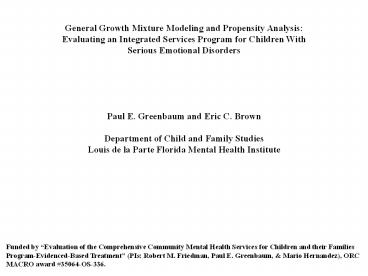General Growth Mixture Modeling and Propensity Analysis: - PowerPoint PPT Presentation
Title:
General Growth Mixture Modeling and Propensity Analysis:
Description:
Title: PowerPoint Presentation Author: GHOST4200CONT Last modified by: GHOST4200CONT Created Date: 2/7/2002 3:31:14 PM Document presentation format – PowerPoint PPT presentation
Number of Views:52
Avg rating:3.0/5.0
Title: General Growth Mixture Modeling and Propensity Analysis:
1
General Growth Mixture Modeling and Propensity
Analysis Evaluating an Integrated Services
Program for Children With Serious Emotional
Disorders
Paul E. Greenbaum and Eric C. Brown Department
of Child and Family Studies Louis de la Parte
Florida Mental Health Institute
Funded by Evaluation of the Comprehensive
Community Mental Health Services for Children and
their Families Program-Evidenced-Based Treatment
(PIs Robert M. Friedman, Paul E. Greenbaum,
Mario Hernandez), ORC MACRO award 35064-OS-336.
2
Background
Intervention System-of-Care
integrated services for children with emotional
and behavioral problems. Theory
states that providing a full-range of
community-based, child-centered (individualized),
culturally competent, and family-focused services
will reduce childrens problem behavior. Sites
Demonstration site, Stark County--a
System-of-Care public mental health system that
supplied integrated services. Comparison site,
Youngstown--a traditional public mental health
system. Sites were from the same
State and matched on county demographics for
gender, age, and race/ethnicity.
3
Method
Participants Participants were
consecutively enrolled. 442 children and
their primary caretakers. Mean age was
11.3 years (SD 3.2) ranging from 6 to 17
years. Stark (n 228) and Youngstown (n
214). Measure Delinquent
Syndrome Scale of the Child Behavior
Checklist/4-18 (Achenbach, 1991). 13
items, each rated on a 3-point scale (Not true,
Sometimes True, Often True).
4
Figure 1. Site Effect Unadjusted for
Propensity Score
Delinquent CBCL Score
Time
5
Figure 2. Site Effect Adjusted for Propensity
Score
Delinquent CBCL Score
Time
6
Figure 3. GGMM 4 Classes - Propensity Score
Adjusted
Delinquent CBCL Score
41
21
33
4
Time
7
Figure 4. CLASS 4 Site Effect
Delinquent CBCL Score
Time
8
Figure 5. CLASS 3 Site Effect
Delinquent CBCL Score
Time































